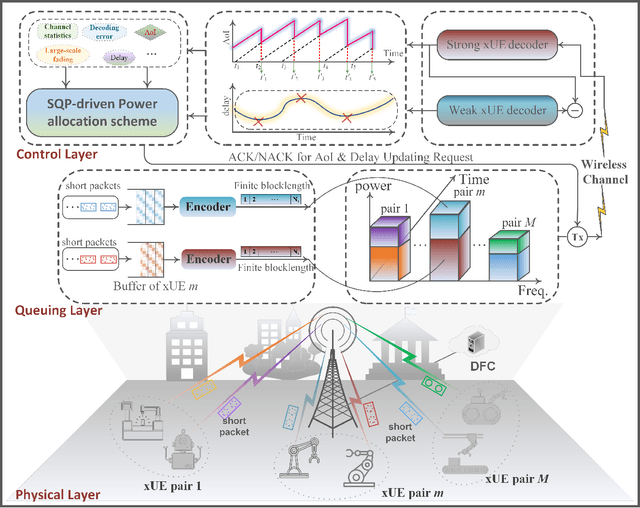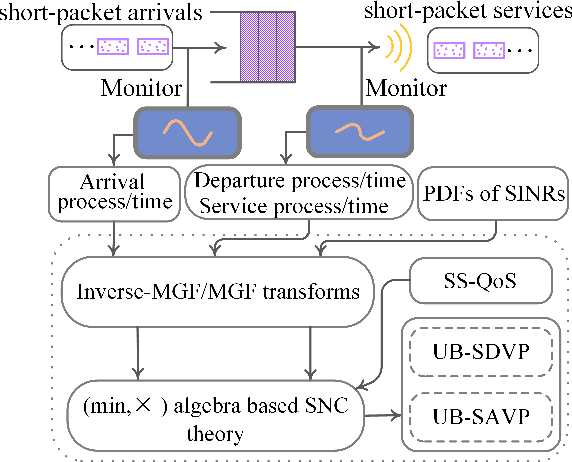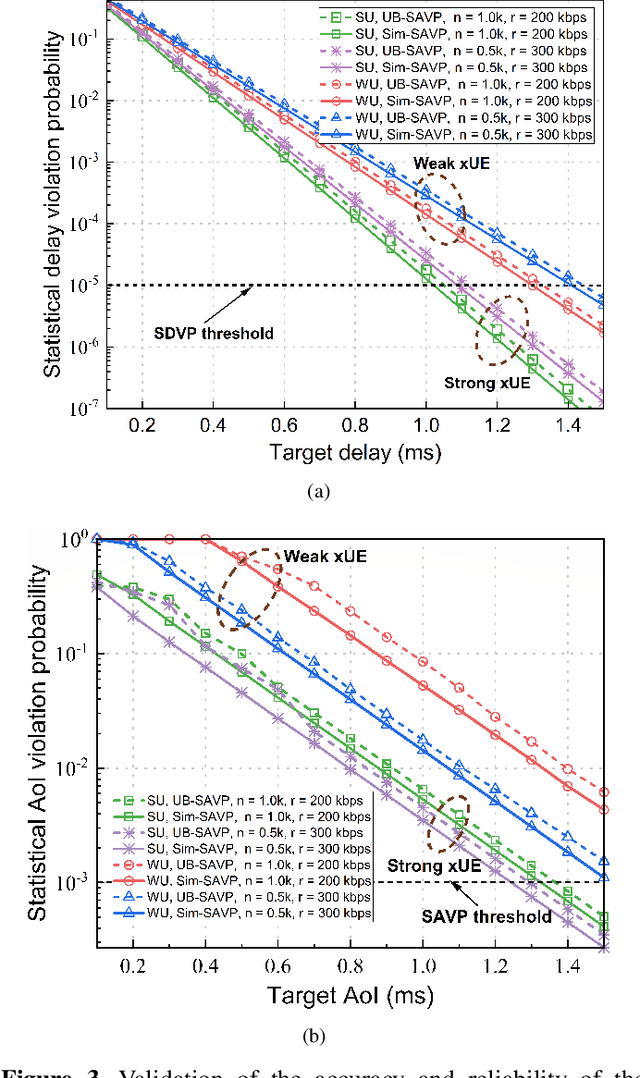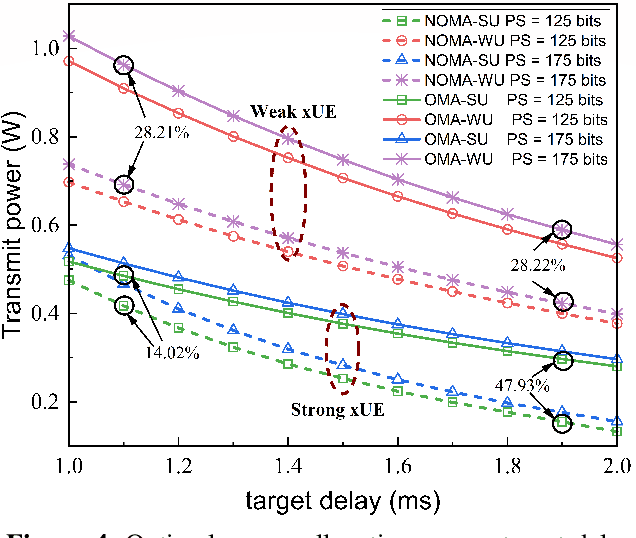Arumugam Nallanathan
Large Language Model-Empowered Decision Transformer for UAV-Enabled Data Collection
Sep 17, 2025Abstract:The deployment of unmanned aerial vehicles (UAVs) for reliable and energy-efficient data collection from spatially distributed devices holds great promise in supporting diverse Internet of Things (IoT) applications. Nevertheless, the limited endurance and communication range of UAVs necessitate intelligent trajectory planning. While reinforcement learning (RL) has been extensively explored for UAV trajectory optimization, its interactive nature entails high costs and risks in real-world environments. Offline RL mitigates these issues but remains susceptible to unstable training and heavily rely on expert-quality datasets. To address these challenges, we formulate a joint UAV trajectory planning and resource allocation problem to maximize energy efficiency of data collection. The resource allocation subproblem is first transformed into an equivalent linear programming formulation and solved optimally with polynomial-time complexity. Then, we propose a large language model (LLM)-empowered critic-regularized decision transformer (DT) framework, termed LLM-CRDT, to learn effective UAV control policies. In LLM-CRDT, we incorporate critic networks to regularize the DT model training, thereby integrating the sequence modeling capabilities of DT with critic-based value guidance to enable learning effective policies from suboptimal datasets. Furthermore, to mitigate the data-hungry nature of transformer models, we employ a pre-trained LLM as the transformer backbone of the DT model and adopt a parameter-efficient fine-tuning strategy, i.e., LoRA, enabling rapid adaptation to UAV control tasks with small-scale dataset and low computational overhead. Extensive simulations demonstrate that LLM-CRDT outperforms benchmark online and offline RL methods, achieving up to 36.7\% higher energy efficiency than the current state-of-the-art DT approaches.
Pinching-Antenna Systems (PASS): A Tutorial
Aug 11, 2025Abstract:Pinching antenna systems (PASS) present a breakthrough among the flexible-antenna technologies, and distinguish themselves by facilitating large-scale antenna reconfiguration, line-of-sight creation, scalable implementation, and near-field benefits, thus bringing wireless communications from the last mile to the last meter. A comprehensive tutorial is presented in this paper. First, the fundamentals of PASS are discussed, including PASS signal models, hardware models, power radiation models, and pinching antenna activation methods. Building upon this, the information-theoretic capacity limits achieved by PASS are characterized, and several typical performance metrics of PASS-based communications are analyzed to demonstrate its superiority over conventional antenna technologies. Next, the pinching beamforming design is investigated. The corresponding power scaling law is first characterized. For the joint transmit and pinching design in the general multiple-waveguide case, 1) a pair of transmission strategies is proposed for PASS-based single-user communications to validate the superiority of PASS, namely sub-connected and fully connected structures; and 2) three practical protocols are proposed for facilitating PASS-based multi-user communications, namely waveguide switching, waveguide division, and waveguide multiplexing. A possible implementation of PASS in wideband communications is further highlighted. Moreover, the channel state information acquisition in PASS is elaborated with a pair of promising solutions. To overcome the high complexity and suboptimality inherent in conventional convex-optimization-based approaches, machine-learning-based methods for operating PASS are also explored, focusing on selected deep neural network architectures and training algorithms. Finally, several promising applications of PASS in next-generation wireless networks are highlighted.
Wireless Sensing via Pinching-Antenna Systems
May 21, 2025Abstract:A wireless sensing architecture via pinching antenna systems is proposed. Compared to conventional wireless systems, PASS offers flexible antenna deployment and improved probing performance for wireless sensing by leveraging dielectric waveguides and pinching antennas (PAs). To enhance signal reception, leaky coaxial (LCX) cables are used to uniformly collect echo signals over a wide area. The Cram\'er-Rao bound (CRB) for multi-target sensing is derived and then minimized through the joint optimization of the transmit waveform and the positions of PAs. To solve the resulting highly coupled, non-convex problem, a two-stage particle swarm optimization (PSO)-based algorithm is proposed. Numerical results demonstrate significant gains in sensing accuracy and robustness over conventional sensing systems, highlighting the benefits of integrating LCX-based reception with optimized PASS configurations.
Pinching-Antenna Systems (PASS): Power Radiation Model and Optimal Beamforming Design
Apr 30, 2025Abstract:Pinching-antenna systems (PASS) improve wireless links by configuring the locations of activated pinching antennas along dielectric waveguides, namely pinching beamforming. In this paper, a novel adjustable power radiation model is proposed for PASS, where power radiation ratios of pinching antennas can be flexibly controlled by tuning the spacing between pinching antennas and waveguides. A closed-form pinching antenna spacing arrangement strategy is derived to achieve the commonly assumed equal-power radiation. Based on this, a practical PASS framework relying on discrete activation is considered, where pinching antennas can only be activated among a set of predefined locations. A transmit power minimization problem is formulated, which jointly optimizes the transmit beamforming, pinching beamforming, and the numbers of activated pinching antennas, subject to each user's minimum rate requirement. (1) To solve the resulting highly coupled mixed-integer nonlinear programming (MINLP) problem, branch-and-bound (BnB)-based algorithms are proposed for both single-user and multi-user scenarios, which is guaranteed to converge to globally optimal solutions. (2) A low-complexity many-to-many matching algorithm is further developed. Combined with the Karush-Kuhn-Tucker (KKT) theory, locally optimal and pairwise-stable solutions are obtained within polynomial-time complexity. Simulation results demonstrate that: (i) PASS significantly outperforms conventional multi-antenna architectures, particularly when the number of users and the spatial range increase; and (ii) The proposed matching-based algorithm achieves near-optimal performance, resulting in only a slight performance loss while significantly reducing computational overheads. Code is available at https://github.com/xiaoxiaxusummer/PASS_Discrete
Joint Transmit and Pinching Beamforming for PASS: Optimization-Based or Learning-Based?
Feb 12, 2025Abstract:A novel pinching antenna system (PASS)-enabled downlink multi-user multiple-input single-output (MISO) framework is proposed. PASS consists of multiple waveguides spanning over thousands of wavelength, which equip numerous low-cost dielectric particles, named pinching antennas (PAs), to radiate signals into free space. The positions of PAs can be reconfigured to change both the large-scale path losses and phases of signals, thus facilitating the novel pinching beamforming design. A sum rate maximization problem is formulated, which jointly optimizes the transmit and pinching beamforming to adaptively achieve constructive signal enhancement and destructive interference mitigation. To solve this highly coupled and nonconvex problem, both optimization-based and learning-based methods are proposed. 1) For the optimization-based method, a majorization-minimization and penalty dual decomposition (MM-PDD) algorithm is developed, which handles the nonconvex complex exponential component using a Lipschitz surrogate function and then invokes PDD for problem decoupling. 2) For the learning-based method, a novel Karush-Kuhn-Tucker (KKT)-guided dual learning (KDL) approach is proposed, which enables KKT solutions to be reconstructed in a data-driven manner by learning dual variables. Following this idea, a KDL-Tranformer algorithm is developed, which captures both inter-PA/inter-user dependencies and channel-state-information (CSI)-beamforming dependencies by attention mechanisms. Simulation results demonstrate that: i) The proposed PASS framework significantly outperforms conventional massive multiple input multiple output (MIMO) system even with a few PAs. ii) The proposed KDL-Transformer can improve over 30% system performance than MM-PDD algorithm, while achieving a millisecond-level response on modern GPUs.
Diffusion Model for Multiple Antenna Communications
Feb 03, 2025



Abstract:The potential of applying diffusion models (DMs) for multiple antenna communications is discussed. A unified framework of applying DM for multiple antenna tasks is first proposed. Then, the tasks are innovatively divided into two categories, i.e., decision-making tasks and generation tasks, depending on whether an optimization of system parameters is involved. For each category, it is conceived 1) how the framework can be used for each task and 2) why the DM is superior to traditional artificial intelligence (TAI) and conventional optimization tasks. It is highlighted that the DMs are well-suited for scenarios with strong interference and noise, excelling in modeling complex data distribution and exploring better actions. A case study of learning beamforming with a DM is then provided, to demonstrate the superiority of the DMs with simulation results. Finally, the applications of DM for emerging multiple antenna technologies and promising research directions are discussed.
GPASS: Deep Learning for Beamforming in Pinching-Antenna Systems (PASS)
Feb 03, 2025Abstract:A novel GPASS architecture is proposed for jointly learning pinching beamforming and transmit beamforming in pinching antenna systems (PASS). The GPASS is with a staged architecture, where the positions of pinching antennas are first learned by a sub-GNN. Then, the transmit beamforming is learned by another sub-GNN based on the antenna positions. The sub-GNNs are incorporated with the permutation property of the beamforming policy, which helps improve the learning performance. The optimal solution structure of transmit beamforming is also leveraged to simplify the mappings to be learned. Numerical results demonstrate that the proposed architecture can achieve a higher SE than a heuristic baseline method with low inference complexity.
Vehicular Multi-Tier Distributed Computing with Hybrid THz-RF Transmission in Satellite-Terrestrial Integrated Networks
Jan 26, 2025Abstract:In this paper, we propose a Satellite-Terrestrial Integrated Network (STIN) assisted vehicular multi-tier distributed computing (VMDC) system leveraging hybrid terahertz (THz) and radio frequency (RF) communication technologies. Task offloading for satellite edge computing is enabled by THz communication using the orthogonal frequency division multiple access (OFDMA) technique. For terrestrial edge computing, we employ non-orthogonal multiple access (NOMA) and vehicle clustering to realize task offloading. We formulate a non-convex optimization problem aimed at maximizing computation efficiency by jointly optimizing bandwidth allocation, task allocation, subchannel-vehicle matching and power allocation. To address this non-convex optimization problem, we decompose the original problem into four sub-problems and solve them using an alternating iterative optimization approach. For the subproblem of task allocation, we solve it by linear programming. To solve the subproblem of sub-channel allocation, we exploit many-to-one matching theory to obtain the result. The subproblem of bandwidth allocation of OFDMA and the subproblem of power allocation of NOMA are solved by quadratic transformation method. Finally, the simulation results show that our proposed scheme significantly enhances the computation efficiency of the STIN-based VMDC system compared with the benchmark schemes.
When xURLLC Meets NOMA: A Stochastic Network Calculus Perspective
Jan 11, 2025



Abstract:The advent of next-generation ultra-reliable and low-latency communications (xURLLC) presents stringent and unprecedented requirements for key performance indicators (KPIs). As a disruptive technology, non-orthogonal multiple access (NOMA) harbors the potential to fulfill these stringent KPIs essential for xURLLC. However, the immaturity of research on the tail distributions of these KPIs significantly impedes the application of NOMA to xURLLC. Stochastic network calculus (SNC), as a potent methodology, is leveraged to provide dependable theoretical insights into tail distribution analysis and statistical QoS provisioning (SQP). In this article, we develop a NOMA-assisted uplink xURLLC network architecture that incorporates an SNC-based SQP theoretical framework (SNC-SQP) to support tail distribution analysis in terms of delay, age-of-information (AoI), and reliability. Based on SNC-SQP, an SQP-driven power optimization problem is proposed to minimize transmit power while guaranteeing xURLLC's KPIs on delay, AoI, reliability, and power consumption. Extensive simulations validate our proposed theoretical framework and demonstrate that the proposed power allocation scheme significantly reduces uplink transmit power and outperforms conventional schemes in terms of SQP performance.
Unveiling the Potential of NOMA: A Journey to Next Generation Multiple Access
Dec 22, 2024



Abstract:Revolutionary sixth-generation wireless communications technologies and applications, notably digital twin networks (DTN), connected autonomous vehicles (CAVs), space-air-ground integrated networks (SAGINs), zero-touch networks, industry 5.0, and healthcare 5.0, are driving next-generation wireless networks (NGWNs). These technologies generate massive data, requiring swift transmission and trillions of device connections, fueling the need for sophisticated next-generation multiple access (NGMA) schemes. NGMA enables massive connectivity in the 6G era, optimizing NGWN operations beyond current multiple access (MA) schemes. This survey showcases non-orthogonal multiple access (NOMA) as NGMA's frontrunner, exploring What has NOMA delivered?, What is NOMA providing?, and What lies ahead?. We present NOMA variants, fundamental operations, and applicability in multi-antenna systems, machine learning, reconfigurable intelligent surfaces (RIS), cognitive radio networks (CRN), integrated sensing and communications (ISAC), terahertz networks, and unmanned aerial vehicles (UAVs). Additionally, we explore NOMA's interplay with state-of-the-art wireless technologies, highlighting its advantages and technical challenges. Finally, we unveil NOMA research trends in the 6G era and provide design recommendations and future perspectives for NOMA as the leading NGMA solution for NGWNs.
 Add to Chrome
Add to Chrome Add to Firefox
Add to Firefox Add to Edge
Add to Edge